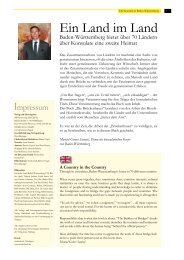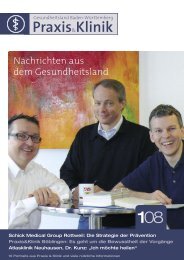WerteLand Baden-Württemberg - PR Presseverlag Süd GmbH
WerteLand Baden-Württemberg - PR Presseverlag Süd GmbH
WerteLand Baden-Württemberg - PR Presseverlag Süd GmbH
Erfolgreiche ePaper selbst erstellen
Machen Sie aus Ihren PDF Publikationen ein blätterbares Flipbook mit unserer einzigartigen Google optimierten e-Paper Software.
118 <strong>WerteLand</strong> <strong>Baden</strong>-<strong>Württemberg</strong><br />
The Conquest of the Skies. The Dream of Flight.<br />
Since the beginning of time, man has wanted to<br />
conquer the universe above him. As Ovid (43 BCE<br />
0-17 CE) described, Daedalus invented the wings<br />
that were to free himself and his son Icarus from<br />
the tyranny of Minos. Although Daedalus warned<br />
his son about the heat of the sun, and the spray<br />
from the sea, Icarus flew too recklessly, and rose<br />
too close to the sun. The heat melted the wax which<br />
held the wings together and he came crashing back<br />
to earth.<br />
Leonardo da Vinci (1452-1519) constructed muscle-powered<br />
swinging wings, a parachute, and the<br />
forerunner of the helicopter.<br />
How <strong>Baden</strong> and <strong>Württemberg</strong> conquered the skies.<br />
We should never forget aviation pioneers such as<br />
Otto Lilienthal (1848-1896), Gustav Weißkopf<br />
(1874-1927) and the brothers Wilbur Wright (1867-<br />
1912) and Orville Wright (1871-1948), and the<br />
many other famous names, whose inventions and<br />
personal courage advanced the development of<br />
flight throughout the world. Nevertheless it is interesting<br />
to look back at the parts <strong>Baden</strong> and <strong>Württemberg</strong><br />
played in the history of aviation. More<br />
than one hundred years ago, the dream of manned<br />
flight was still alive in this region and a few short<br />
decades later it began to grow in importance.<br />
Albrecht Ludwig Berblinger (1770-1829), a tailor<br />
from Ulm, built a glider that was capable of flight,<br />
but he came to grief in two demonstrations for the<br />
King. Max Eyth captured the drama of 1811 in the<br />
title of his novel: “The tailor of Ulm. History of a<br />
man born two hundred years too early“. On 12th<br />
August 1888, the first motor-driven airship in the<br />
world rose above the courtyard of the Daimler‘ factory<br />
on a four-kilometre flight powered by a Daimler<br />
motor. It was designed by Dr. Karl Wölfert, a<br />
bookseller from Leipzig.<br />
The LZ1, which was powered by two four-cylinder<br />
motors, each with 16 HP, was designed by<br />
Ferdinand Graf von Zeppelin (1838-1917), who<br />
was born in Constance. On the 2nd of July 1900<br />
it lifted off from that town for a flight across Lake<br />
Constance.<br />
Hellmut Hirth (1886-1938) from Heilbronn made<br />
his first ventures aloft from the Cannstatt Wasen<br />
(then the first airfield in South-West Germany) with<br />
a Daimler 50-HP airship engine, in 1909 and 1910.<br />
And in 1929, the first large-bodied aircraft in the<br />
world, the D-Wal flying boat, was built at the aircraft<br />
wharf in Friedrichshafen which was founded<br />
by Claudius Dornier (1914-1986) from Friedrichshafen:<br />
It had a range of 2,200 kilometres and could<br />
carry 169 passengers.<br />
Light materials and resistance to air pressure were<br />
the ecological and economic challenges of the<br />
era. At this point we should also remember Hans<br />
Klemm (1885-1961) from Stuttgart, the Swabian<br />
engineer and entrepreneur. His lightweight aircraft<br />
made him one of the most important pioneers in<br />
aircraft construction and his Böblingen-based company<br />
was a crucible of ideas that influenced the<br />
progress and future of the aircraft industry.<br />
In 1910, the aircraft designer Ernst Heinkel<br />
(1888-1958) from Grunbach took off from the<br />
Cannstatt Wasen in his biplane.<br />
He had built the world‘s first catapult aircraft.<br />
1939 saw the first airplane powered by a liquid<br />
fuel jet engine. It was also the first airplane with<br />
a turbo-engine.<br />
Hans Holzwarth (1877-1953) from Dornhan<br />
built a „gas turbine with combustion chamber“.<br />
This was the predecessor to his Holzwarth turbine,<br />
which formed the technical basis for modern<br />
passenger aircrafts.<br />
The “first ascent“ of space<br />
Men walk on the moon<br />
The start of the 20th century saw the first forays<br />
into space. Pioneers, discoverers, enthusiasts and<br />
inventors were the people who gave the starting<br />
impulse to a dynamic that is unequalled in human<br />
history: Konstantin E. Ziolkowski (1857-<br />
1935) formulated the Ideal Rocket Equation.<br />
v(t)=v(g).1n(m(0) : m(t) )<br />
Ideal Rocket Equation<br />
The most basic laws of rocket propulsion<br />
through the continual expulsion of propellant.<br />
Calculation of the final velocity of the<br />
rocket, taking into account exhaust velocity,<br />
take-off weight and weight after consumption<br />
of the propellant, as a logarithm from<br />
full weight to empty weight. Defined by<br />
Ziolkowski, Oberth, Goddard)<br />
Robert Goddard (1882-1945) developed solid<br />
fuel and later liquid fuel rockets. Hermann<br />
Oberth (1894-1989) opened up new dimensions<br />
with his books “By Rocket into Planetary Space“<br />
and “Ways to Spaceflight“.<br />
Eugen Sänger worked on a “space boat“ which<br />
was intended to transport goods and people between<br />
the Earth and orbit ... Parts of his work<br />
were later used in the Space Shuttle.<br />
And finally there was Wernher von Braun (1912-<br />
1977), who played a decisive role in the Mercury,<br />
Gemini and Apollo projects, and who is rightly<br />
called the intellectual Father of the moon<br />
rockets.<br />
<strong>WerteLand</strong> <strong>Baden</strong>-<strong>Württemberg</strong> 119
















